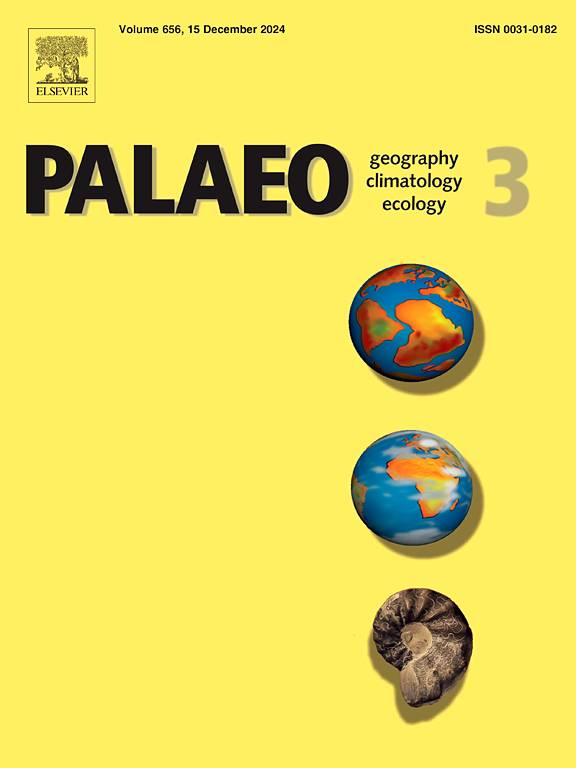南黄海全新世沉积物物源与环境变化
IF 2.7
2区 地球科学
Q2 GEOGRAPHY, PHYSICAL
Palaeogeography, Palaeoclimatology, Palaeoecology
Pub Date : 2025-03-02
DOI:10.1016/j.palaeo.2025.112861
引用次数: 0
摘要
边缘海沉积物是研究物源和环境变化的宝贵档案。在这项研究中,我们利用大量样品和不同粒度的碳酸盐分布,研究了碳酸盐含量在全新世的高分辨率变化。我们的分析综合了底栖有孔虫丰度、碎屑矿物和稳定的碳氧同位素组成,这些同位素来自一个年代确定的沉积物岩心,co2(34°59.89΄N, 122°0.03΄E;水深52.5 m),在黄海南部有泥沉积。大量样品分析揭示了过去11.2 ka BP的三个不同的沉积阶段。全新世早期沉积物碳酸盐含量最高,平均为4.53%。大部分碳酸盐(约80%)分布在<;38 μm粒度层中,表明第三阶段(11.2-10.1 ka BP)为低海岸盐栖有孔虫组合的海洋环境。在第II阶段(10.1 ~ 6.5 ka BP), 38 μm粒级碳酸盐的贡献降至60%,表明黄河输沙量略有减少,但较长江输沙量有所增加。底栖有孔虫稳定的碳氧同位素组成支持这一观点。此外,我们的研究表明,底栖有孔虫丰度在9 ka和7.3 ka BP左右的两个高峰期间增加,分别对应于融化水脉冲(MWP)-1C和MWP- 1d期间海平面的突然上升。第1阶段(6.5 ~ 4 ka BP),海平面接近现代水平,形成现代环流格局。在过去的4ka BP中,发生了一段非沉积期,可能与东亚季风驱动的水文变化有关。碳酸盐含量,特别是沉积物中不同粒度组分的碳酸盐含量,为研究边缘海域全新世环境演化提供了有价值的信息。这些发现对于认识黄海古环境史和过去全球变化具有重要意义,强调了本研究的重要意义。本文章由计算机程序翻译,如有差异,请以英文原文为准。
Provenance and environmental changes recorded in Holocene sediments from the Southern Yellow Sea, China
Marine sediments in marginal seas serve as valuable archives of provenance and environmental changes. In this study, we investigate high-resolution Holocene variations in carbonate content using bulk samples and different particle sizes of carbonate distribution. Our analysis integrates benthic foraminiferal abundances, detrital minerals, and stable carbon and oxygen isotopic compositions from a well-dated sediment core, C02 (34°59.89΄N, 122°0.03΄E; water depth 52.5 m), in the southern Yellow Sea mud deposits. The bulk sample analysis reveals three distinct phases of sedimentation over the past 11.2 ka BP. The highest sediment carbonate content (averaging 4.53 %) occurred during the early Holocene. The majority of carbonate (about 80 %) is found in the <38 μm grain size fraction, indicating an offshore environment during stage III (11.2–10.1 ka BP) characterized by low coastal saline benthic foraminifera assemblages. In stage II (10.1–6.5 ka BP), the contribution of carbonate from the <38 μm grain size fraction decreased to 60 %, suggesting a slight decrease in sediment supply from the Yellow River but an increase compared to the Yangtze River. Stable carbon and oxygen isotopic compositions of benthic foraminifera support this. Additionally, our study has revealed that benthic foraminifera abundance increased during two peaks around 9 ka and 7.3 ka BP, corresponding to abrupt sea level rises during meltwater pulses (MWP)-1C and MWP-1D, respectively. During stage I (6.5–4 ka BP), sea level approached modern levels, and a modern-day circulation pattern was established. A period of non-deposition occurred over the last 4 ka BP, possibly linked to hydrological changes driven by the East Asian monsoon. The carbonate content, especially in different particle size fractions of the sediment, offers valuable insights into Holocene environmental evolution in marginal seas. These findings are crucial for understanding the paleoenvironmental history of the Yellow Sea and past global changes, underlining the significance of our study.
求助全文
通过发布文献求助,成功后即可免费获取论文全文。
去求助
来源期刊
CiteScore
5.90
自引率
10.00%
发文量
398
审稿时长
3.8 months
期刊介绍:
Palaeogeography, Palaeoclimatology, Palaeoecology is an international medium for the publication of high quality and multidisciplinary, original studies and comprehensive reviews in the field of palaeo-environmental geology. The journal aims at bringing together data with global implications from research in the many different disciplines involved in palaeo-environmental investigations.
By cutting across the boundaries of established sciences, it provides an interdisciplinary forum where issues of general interest can be discussed.

 求助内容:
求助内容: 应助结果提醒方式:
应助结果提醒方式:


